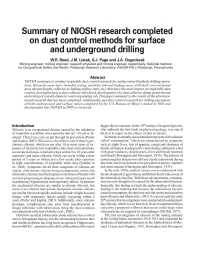Mining Publication: Summary of NIOSH Research Completed on Dust Control Methods for the Surface and Underground Drilling
Original creation date: December 2008
NIOSH continues to conduct respirable dust control research for surface mine blasthole drilling operations. Research areas have included testing variables (shroud leakage area, drill deck cross-sectional area, shroud height, collector-to-bailing airflow ratio, etc.) that have the most impact on respirable dust control, development of a dust collector inlet hood, development of a dust collector dump point shroud, and testing of a small diameter water separating sub. This paper summarizes the results of the aforementioned research that has been completed. Additionally, past dust control research for drilling operations of both underground and surface mines completed by the U.S. Bureau of Mines (created in 1910 and incorporated into NIOSH in 1997) is reviewed.
Authors: WR Reed, JM Listak, SJ Page, JA Organiscak
Peer Reviewed Journal Article - December 2008
NIOSHTIC2 Number: 20034926
Trans Soc Min Metall Explor 2008 Dec; 324:32-40
See Also
- Best Practices for Controlling Respirable Dust in Coal Mines
- Dust Underfoot: Enclosed Cab Floor Heaters Can Significantly Increase Operator's Respirable Dust Exposure
- Evaluation of the Approach to Respirable Quartz Exposure Control in U.S. Coal Mines
- Improved Drill Shroud Capture of Respirable Dust Utilizing Air Nozzles Underneath the Drill Deck
- Improving Silica Dust Control Through Targeted Research
- Improving the Performance of Fan-Powered Dust Collectors in Stone-Cutting Applications
- Laboratory Testing To Quantify Dust Entrainment During Shield Advance
- Performance of a Light Scattering Dust Monitor at Various Air Velocities: Results of Sampling in the Active Versus the Passive Mode
- Technology News 447 - Dust Collector Discharge Shroud Reduces Dust Exposure to Drill Operators at Surface Coal Mines
- Technology News 509 - A New Method to Clean Dust From Soiled Work Clothes
- Content source: National Institute for Occupational Safety and Health, Mining Program


 ShareCompartir
ShareCompartir
